With a recorded history of more than 2500 years Sri Lanka has a rich heritage. There are 8 world heritage sites within the country which include; The hill capital Kandy, The sacred city of Anuradapura, The Dutch fort of Galle, The ancient city of Polonnaruwa, The rock fortress of Sigiriya, The golden rock temple of Dambulla, The beautiful Horton plains and The Singharaja rain forest. Apart from these famous sites there are hundreds of heritage sites in the island which are frequented by tourists.
Anuradapura
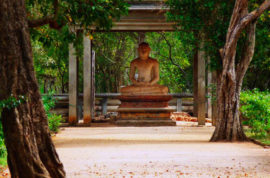
Anuradhapura first became a capital in 380 BC under Pandukabhaya, but it was under Devanampiya Tissa (BC 247–207 BC), during whose reign Buddhism reached Sri Lanka, that it first rose to great importance. Soon Anuradhapura became a great and glittering city, only to fall before a South Indian invasion – a fate that was to befall it repeatedly for more than 1000 years. But before long the Sinhalese hero Dutugemunu led an army from a refuge in the far south to recapture Anuradhapura. The ‘Dutu’ part of his name, incidentally, means ‘undutiful’, because his father, fearing for his son’s safety, forbade him to attempt to recapture Anuradhapura. Dutugemunu disobeyed him, and later sent his father a woman’s ornament to indicate what he thought of his courage.
Dutugemunu (r 161–137 BC) set in motion a vast building program that included some of the most impressive monuments in Anuradhapura today. Other important kings who followed him included Valagamba, who lost his throne in another Indian invasion but later regained it, and Mahasena (r AD 276–303), the last ‘great’ king of Anuradhapura, who was the builder of the colossal Jetavanarama Dagoba. He also held the record for tank construction, building 16 of them in all, plus a major canal. Anuradhapura was to survive for another 500 years before finally being replaced by Polonnaruwa, but it was harassed by invasions from South India again and again – invasions made easier by the cleared lands and great roads that were a product of Anuradhapura’s importance.
Sigiriya
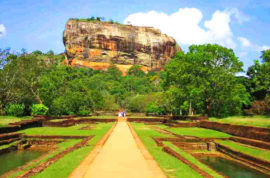
Sigiriya Rock Fortress of Sri Lanka is situated in Matale district near Dambulla. It can be reached along Colombo- Habarana highway by turning towards east from Inamaluwa. Proceeding about 10 km from Inamaluwa and passing Kimbissa township one arrives at Sigiriya. Before Sigiriya became a Kingdom, Sigiriya Rock base and the places such as Pidurangala which were endowed with many caves and a temple had been dwelled by Buddhist monks from around 3rd Century BC. It is also found that these areas had been inhabitant by people prior to King Kassapa’s rein. Many caves have Brahmi Inscriptions dating back from 3rd Century BC to 1st century AD.
Sigiriya being a fortress, had been well designed for its defenses by having ramparts and moats built around it. There are several approaches to the inner city and the most prominent is the Western entrance. From the summit of the rock, the land areas up to distances of tens of miles can be watched making it hard for the enemy to make a surprise attack to the kingdom. King Kassapa had reverted his fortress to an ecological wonder by having Royal Pleasure Gardens, Water Gardens , Fountain Gardens and Boulder Gardens made inside the inner city as well as at the palace premises on the Rock summit.
Polonnaruwa
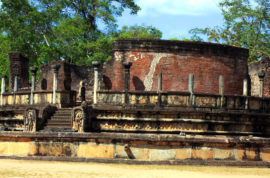
For three centuries Polonnaruwa was a royal capital of both the Chola and Sinhalese kingdoms. Although nearly 1000 years old, it is much younger than Anuradhapura and generally in better repair. The monuments are arranged in a reasonably compact garden setting and their development is easier to follow. All in all, you’ll probably find Polonnaruwa the easier of the two ancient capitals to appreciate. It is best to explore by bicycle, which you can rent from several places in town.
Parakramabahu I was followed by Nissanka Malla (r 1187–96), who virtually bankrupted the kingdom through his attempts to match his predecessors’ achievements. By the early 13th century, Polonnaruwa was beginning to prove as susceptible to Indian invasion as Anuradhapura, and eventually it too was abandoned and the centre of Sinhalese power shifted to the western side of the island.In 1982, Unesco added the ancient city of Polonnaruwa to its World Heritage list.
Kandy
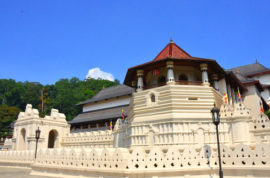
Kandy, the last royal capital of Sri Lanka is a major tourist destination. ( 115kM from Colombo at 465 meters above sea level). Famous for the Temple of the Tooth and many other temples the city could be called the cultural capital of the island.Kandy Perahera, the pageant of the temple of tooth where Buddha’s tooth is kept is held either in July or August each year to parade the golden caskets is a must see itenary if one is visiting Sri Lanka during these months. The final night procession is the most spectacular event of the country. More than 50 elephants parade the city accompanied by the drummers, dancers and chieftains.
he city established in the 15th century was the last royal capital where 2500 years of royal rule ended. This bustling market town is rich in cultural diversity has plenty of iteneries to offer to the tourists from songs dances and handy crafts to ancient temples and adventure activities. Kandy is a good transit point to the cultural triangle to the north or hill country to the south. The city is also a good source of souvenirs or to experience many cultural performances at it’s various hotels in the city.
Galle
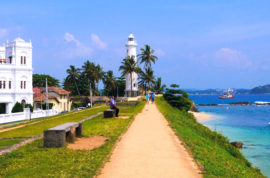
Galle-located 116 km to the south of Colombo on the southwest corner of the island-was founded in the 16th century by the Portuguese. It is the best example of a fortified city built by Europeans in South and South-East Asia, showing the interaction between European architectural styles and South Asian traditions. Galle has been declared a World Heritage City by the UNESCO. Dutch Museum:The Dutch Museum which is housed in a restored Dutch mansion of the time, contains paintings, prints, documents, furniture and ceramics from the Dutch colonial era.
Koggala, near Galle is the hometown of a famous local writer Martin Wickramasinghe. The museum of Folk, Art & Culture built in his honour at his old residence has an excellent display of local folk items. They include the costumes of folk dancers, sports items, household items and furniture and vast arena of the folk life of the early 20th century. Take a boat trip in the lagoon and Kogggala Lake to see many of its small islands, which is a popular destination for bird watching. Dutch Reformed Church: Built by a Dutch Army officer at the site of a previous Portuguese church and completed in 1754 the church is situated close to the new entrance to the fort. The church contains record of marriages since 1748 and baptism from 1678. The major highlight of the building is there are no pillars inside the building and the weight of the roof is supported by the walls.
Galle
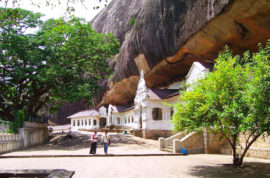
Located about 19 kms from Sigiriya, Dambulla is home to the Dambulla Cave Centre, a UNESCO World Heritage Site. Dambulla lies approximately 148 kilometers (roughly 91 miles) to the Northeast of the Sri Lankan capital, Colombo. It is renowned the world-over for the presence of the Iron Wood Forest, and the Rose Quartz Mountain Range. Dambulla provides historical adventures and breathtaking sights in a region UNESCO has designated the Cultural Triangle. The city is a unique and important historical site because of the amalgamation of the material from many eras.
Major attractions of the Dambulla Cave Centre are spread over 5 caves, which contain the statues and the paintings. Since its foundation in the 1 century BC byKing Valagamba, many modifications have been carried out to the sculptures and paintings. Hindu statues are believed to be of the 12 century AD and the latest paintings are of the late 18-century. The temple is a perfect location to view evolution of the ancient Sri Lankan arts.
